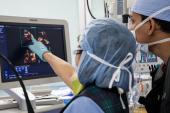Cardiac Imaging’s Carbon Footprint: Time for Awareness and Action
Choosing the right test at the right time matters for individual patients, but also has broader implications for humanity.

Cutting radiation exposure and costs have long been goals in the field of cardiovascular imaging: some say the time has come for imagers and referring physicians to pay more attention to the large carbon footprint these tests can entail.
Climate cardiology is increasingly at the forefront of some cardiologist’s minds, but Eugenio Picano, MD, PhD (Institute of Clinical Physiology, Pisa, Italy), who penned an editorial published last week in the European Heart Journal about the role cardiac imaging plays in climate change, told TCTMD that many “clearly” overlook how their decisions can impact the planet.
“Doctors are well aware now that climate change and air pollution are a major determinants of cardiovascular disease, and they are scared by this impact,” he said. “But they contribute to this impact, and still the awareness, which is the first step for correction, is ignored.”
Commenting on the editorial for TCTMD, American Society of Echocardiography President Stephen Little, MD (Houston Methodist, TX), agreed that this is likely a new concept for many physicians to think about in terms of their professional roles.
If a room full of imagers were asked if they’d considered imaging’s carbon footprint, most probably would say no, he said. “That, in general, would reflect most hospital practices. Hospitals are very focused on patient outcomes in that moment, in that admission, in that interaction—not so much the recycling, the disposables, the elements that are used—simply because it is a very acute focus concept and not necessarily on the long-term horizon of the decision-making.”
Acknowledging the importance of healthcare’s impact on the planet, president-elect of the American Society of Nuclear Cardiology Mouaz Al-Mallah, MD (Houston Methodist), told TCTMD the issue for imagers boils down to: “If we do the right test for the right patient at the right time, we can reduce redundancy in imaging and requests for testing, and thus we can hopefully reduce the environmental footprint.”
Rather than focusing on what imaging modality has the greatest carbon footprint, which can vary based on patient characteristics, available technology, and local expertise, Al-Mallah urged imagers to avoid layered testing and achieve a diagnosis in as few tests as possible.
All Kinds Of Sustainability
In his commentary, Picano refers to several stages of how awareness has evolved within cardiovascular imaging. First, there was the “slice war,” where imagers were determined to increase image resolution regardless of cost and radiation exposure. Then came the “radiation war,” where awareness of the need for safety caused a shift in practice to prioritize the same image quality with less radiation and is now mainstream. The current era he deems the “carbon war,” where focus is needed to obtain “the same image quality with less carbon cost to win in the global competition.”
At the heart of this issue, according to Picano, is awareness. Cardiologists prescribe about half of all medical imaging exams, he said, “but we have little awareness of what we do in terms of environmental footprint, and there is tremendous variation in the production of carbon dioxide per exam. . . . As you can imagine, a small footprint of a single examination multiplied by billions of examinations per year becomes a significant environmental burden.”
The total carbon emissions associated with acquisition, storage, and analysis of cardiac imaging data range from 2 kg for ultrasound to 20-30 kg for a coronary CT angiogram and stress SPECT and around 200-300 kg per stress CMR examination, Picano writes. Additionally, the overall carbon footprint of health care is about 4% in the United Kingdom and 10% in the US, with medical imaging accounting for approximately 10% of that.
For the issue of economic sustainability, Picano pointed out how much the cost of common cardiac tests can vary. “Within the same institution, you can have a fourfold variation for the cost of the same exam,” he said. “Obviously, you cannot make any serious relative cost benefit assessment if you have a variation of this level. So, payers are also important in controlling this variable.”
If we do the right test for the right patient at the right time, we can reduce redundancy in imaging and requests for testing, and thus we can hopefully reduce the environmental footprint. Mouaz Al-Mallah
The concept of “social sustainability,” finds some parallels in the evolution of thinking around radiation exposure and cancer development. Industry, Picano said, played a huge role in lowering the radiation doses associated with a wide variety of imaging modalities, but this only happened after increased awareness in the medical community “forced” the issue. “Now, it is part of mainstream cardiology culture” with tenfold decreases in radiation doses observed in cardiac imaging over the last decade, he added.
“On the road to sustainability, the first step is to be aware of the carbon cost of what we do; the second step is to add this variable in the comprehensive decision-making process including environmental footprint, and the third step is to find in environmental cost a further motivation to avoid unnecessary, low-value testing or to shift toward a lower carbon modality,” Picano writes.
He suggests that a “sustainability index” be calculated based on benefit, direct cost, radiation risk, and carbon cost for any act of diagnosis or therapy across the board of healthcare. The most sustainable option might not be the most accurate option or the one that will provide the most benefit for every patient, Picano acknowledges. “More sustainable practices with affordable, radiation-optimized, and carbon-neutral practices will benefit all stakeholders: patients, physicians, payers, people, and the planet. Prescribing medical imaging is a social—not simply a medical—act,” he says.
Any Actionable Change?
Echoing Picano’s point, Al-Mallah said that “sometimes the right test may be the cheapest test, but sometimes it may not be the cheapest test. By not doing the right tests, we may end up adding redundant testing for these patients, which increases patient exposure, which increases the environmental footprint, and obviously adds cost.” A patient-first approach is always best, he added.
I'd rather continue to focus on what is best for the patient. But to that end, there is a consideration beyond the singular patient that . . . we should be considering other things. Stephen Little
At the end of the day, a physician’s primary duty is to the patient, Al-Mallah said, adding that “we want to obviously do what is right for the environment and we want to do what is right for the overall cost or environmental burden on healthcare.” If presented with two diagnostic options that are similar in terms of accuracy, but one has lower carbon emissions, “I might go with that one, but they have to be really equal to provide information for that patient,” he said.
While the editorial was “thought-provoking,” Little said he would like to see more consensus documents and appropriate use criteria papers discuss carbon footprints, especially beyond the scope of merely cardiac imaging. “It seems like a bit of a leap to jump to cardiac imaging without also thinking about all of the broad house of medicine,” he said. “Where in the delivery of acute or chronic medicine or medical care [more generally] are the carbon footprint elements? I have no idea what that landscape would mean: everything from cafeteria services to porters to physicians flying for CME. It is a very broad conversation around medicine, and medicine within the context of the rest of society.”
Though carbon footprints are a “novel ingredient to this conversation,” Little acknowledged that the medical community is not exempt from considering its broad effect on sustainability.
At this point, Little said it’s unlikely that he will make any specific changes to his practice based on the points raised by Picano, especially since “echo comes out looking very good,” he said. “But I also don't want to necessarily take a competitive approach and think about winning and losing modalities with this index. I'd rather continue to focus on what is best for the patient. But to that end, there is a consideration beyond the singular patient that . . . we should be considering other things.”
Yael L. Maxwell is Senior Medical Journalist for TCTMD and Section Editor of TCTMD's Fellows Forum. She served as the inaugural…
Read Full BioSources
Picano E. Economic, ethical, and environmental sustainability of cardiac imaging. Eur Heart J. 2022;Epub ahead of print.
Disclosures
- Picano and Little report no relevant conflicts of interest.
- Al-Mallah reports receiving research support from Siemens.





Comments